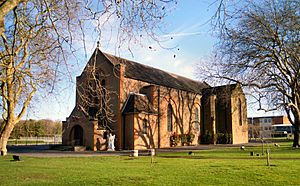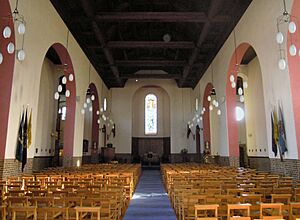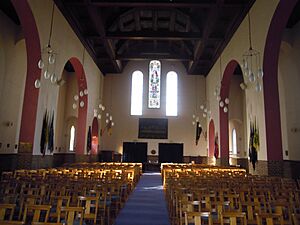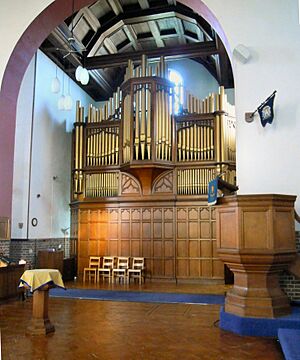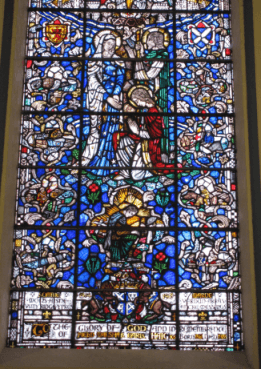St Andrew's Garrison Church, Aldershot facts for kids
St Andrew's Garrison Church is a big army church located in Aldershot, England. It was designed in the late 1920s by a famous Scottish architect named Sir Robert Lorimer.
History of the Church
Sir Robert Lorimer, the architect, also designed many war memorials in the 1920s. St Andrew's Garrison Church was built to remember soldiers who died in World War I (1914-1918). A special sign inside the church says it was built to honor soldiers from the Church of Scotland and similar churches who gave their lives in that war.
Church of Scotland Connections
Even though it's an army church, St Andrew's is not officially a Church of Scotland church. However, most of its ministers have been from the Church of Scotland. The church also uses the same service style and hymn book as the Church of Scotland.
Who Can Attend Services?
Anyone can attend services at St Andrew's Garrison Church. You don't have to be in the military to join the congregation.
Early Church Buildings in Aldershot
An army camp was set up in Aldershot in 1854. Two churches were quickly built there the next year. By 1856, a third church was needed. This was a portable building called the "Iron Church." In 1866, the Iron Church was moved to Queen's Avenue, close to where St Andrew's Garrison Church stands today.
The Iron Church
The Iron Church was used by both Church of Scotland and Church of England ministers until 1893. That year, St George's Garrison Church was built for the Anglicans. After that, the Iron Church was only used by Church of Scotland ministers until it was taken down in 1926. In 1908, the chaplain asked for the Iron Church to be named after Saint Andrew, the patron saint of Scotland. The War Office agreed.
Building the New Church
After World War I, money was collected to replace the Iron Church with a permanent building. This new church would also be a memorial for Church of Scotland and other Presbyterian soldiers who died in the war.
Designing the Church
Sir Robert Lorimer designed this new church. However, because of money limits, the main part of the church (the nave) was built a bit shorter than he first planned. From the outside, the church is mostly brown brick. Its doors, windows, and corners are highlighted with red brick. Inside, the church has a standard cross shape, with an eight-sided area at the east end.
Opening and Extending the Church
Princess Mary officially opened the new St Andrew's Garrison Church on December 10, 1927. However, the church soon became too small for large army ceremonies. By 1938, enough money was raised to make the nave longer. Big donations came from the St Andrew's Scottish Soldiers' Club, the Church of Scotland, and The Treasury. John F. Matthew, who was Sir Robert Lorimer's architectural partner, was hired to design the extension. This made the nave 30 feet longer, just as Lorimer had originally wanted, and made the bell tower shorter.
Reopening with Royalty
On February 5, 1939, the extended St Andrew's Garrison Church was reopened and rededicated. King George VI and Queen Elizabeth were there for the special event.
Later Buildings and Features
In the 1950s, more buildings were added next to the church. These included a hall, kitchen, offices, and toilets. They were built with dark red brick, similar to the main church. The church hall is dedicated to remembering members of the Church of Scotland and other Presbyterian churches who died in World War II.
Statue of St Andrew
After the Royal Caledonian School closed in the 1990s, a statue of St Andrew by J. G. Bubb was given to the church. This statue now stands outside the front of the church. A new marble base was added to the statue around 2003 or 2004.
Protecting the Building
In 2006, Rushmoor Borough Council listed the church building. Being listed means the building has extra protection against big changes or being torn down.
Inside the Church
The inside of the church has a large main area called the nave. It can seat about 420 people. There are no balconies. Two arched walkways run between the nave and the side walls.
Cameron Chapel
The south wing of the church was turned into a small chapel in 1975. It was first called St Andrew's Chapel, but now it's known as the Cameron Chapel. This name comes from a large stained glass window given by the Queen's Own Cameron Highlanders to the church in 1930. This window, along with a plaque and a regimental flag, is in this part of the building. A new communion table was made especially for the chapel's opening in 1975.
The Organ
The north wing of the church has a large organ. The organ is actually older than the church building itself, dating back to 1897. It used to be in St Ninian's Church of Scotland in Leith. In 1984, the organ was fixed up and moved to St Andrew's Garrison Church.
Memorials and Stained Glass
The church has many memorials and stained glass windows. Some were made for the church, while others were moved here over time.
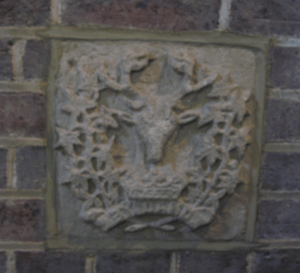
Egyptian Stones
These include 12 stones set into the wall of the Cameron Chapel. German Prisoners of War carved these stones in Egypt during World War II. The stones were first placed in a British army church in Egypt. Ten of them show the cap badges of Scottish Regiments. Two stones show medical badges used in the British Army. When the British Army left Egypt in the mid-1950s, the church closed. A few years later, the stones were moved to St Andrew's in Aldershot.
War Memorials and Regimental Crests
Other memorials moved to the church include:
- Two war memorials from World War I that were originally in Aldershot Presbyterian Church. You can find them in the porch of St Andrew's.
- A monument to Field Marshal, Lord Wavell. This was originally in the Wavell Memorial Chapel, which stopped being used for worship in 1965-1966.
- A window with stained glass showing regimental crests, mostly from Scottish regiments. This window is made up of smaller stained glass pieces that came from the Church of Scotland Canteen in Aldershot, which was torn down in the late 1960s.
Stained Glass Windows
The rest of St Andrew's stained glass windows were made specifically for this church. There is a large stained glass window in the east end of the church that remembers Field-Marshal, Earl Haig. There are also windows honoring the Queen's Own Cameron Highlanders and I Corp. Many other stained glass windows have been given to remember individual people who were part of the church.
The two largest stained glass windows, for I Corp and Earl Haig, were designed by Walter Cook of Edinburgh in the early to mid-1930s. They both show similar ideas. Jesus is the main figure, with his arms outstretched, representing a savior and peace. Below him, a small group of sad people reminds us of the high cost of war, especially World War I.


